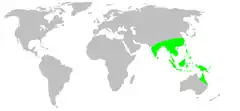Psechridae
Psechridae is a family of araneomorph spiders with about 70 species in two genera.[1][2] These are among the biggest cribellate spiders with body lengths up to 2 centimetres (0.79 in) and funnel webs more than 1 metre (3 ft 3 in) in diameter.[3]
| Psechridae | |
|---|---|
 | |
| Fecenia cylindrata | |
| Scientific classification | |
| Kingdom: | Animalia |
| Phylum: | Arthropoda |
| Subphylum: | Chelicerata |
| Class: | Arachnida |
| Order: | Araneae |
| Infraorder: | Araneomorphae |
| Family: | Psechridae Simon, 1890 |
| Genera | |
| Diversity | |
| 2 genera, 77 species | |
 | |
The family belongs to the RTA clade of spiders because they all have a Retrolateral Tibial Apophysis on the male pedipalp. A recent phylogenetic analysis places Psechridae as close relatives of the lynx spiders, wolf spiders, and nursery web spiders.[4]
They feature several characteristics normally found in ecribellate spiders, for example brood care behavior, and a colulus with no apparent function.[5] They have greatly elongated legs, with the last element being very flexible. Female Psechrus carry their egg-sac in the chelicerae, similar to their relatives, the ecribellate Pisauridae. Members of Psechrus construct horizontal webs lace webs, while Fecenia construct pseudo-orbs, similar to orb webs of Orbiculariae spiders in an example of evolutionary convergence.[4][6]
Distribution
They occur in southeastern Asia, ranging from India in the west, to Solomon Islands in the east, reaching as far south as northern Australia, and north to central China.[7] They are found in forest, rocky areas, and caves from lowlands to altitudes exceeding 2,000 metres (1.2 mi).
Genera
As of April 2019, the World Spider Catalog accepts the following genera:[7]
See also
References
- Bayer, S. (2011). "Revision of the pseudo-orbweavers of the genus Fecenia Simon, 1887 (Araneae, Psechridae), with emphasis on their preepigyne". ZooKeys (153): 1–56. doi:10.3897/zookeys.153.2110. PMC 3238043. PMID 22287909.
- Bayer, S. (2012). "The lace-sheet-weavers—a long story (Araneae: Psechridae: Psechrus)". Zootaxa. 3379: 1. doi:10.11646/zootaxa.3379.1.1.
- Gertsch, Willis J. (1979). American Spiders (2 ed.). Van Nostrand Reinhold, New York. ISBN 0-442-22649-7.
- Agnarsson, I.; Gregorič, M.; Blackledge, T.A.; Kuntner, M.; et al. (2013). "Phylogenetic placement of Psechridae and the convergent origin of orb-like spider webs". Journal of Zoological Systematics and Evolutionary Research. 51. doi:10.1111/jzs.12007.
- Fang, K.; Yang, C.-C.; Lue, B.-W.; Chen, S.H.; Lue, K.-Y.; et al. (2000). "Phylogenetic Corroboration of Superfamily Lycosoidae Spiders (Araneae) as Inferred from Partial Mitochondrial 12S and 16S Ribosomal DNA Sequences" (PDF). Zoological Studies. 39 (2): 107–113.
- Blackledge, T.A.; Kuntner, M.; Agnarsson, I. (2012). "Biomaterial evolution parallels behavioral innovation in the origin of orb-like spider webs". Scientific Reports. 2: 833. Bibcode:2012NatSR...2E.833B. doi:10.1038/srep00833. PMID 23150784.
- "Family: Psechridae Simon, 1890". World Spider Catalog. Natural History Museum Bern. Retrieved 2019-04-23.
Further reading
- Levi, H.W. (1982). The spider genera Psechrus and Fecenia (Araneae, Psechridae). Pacific Insects 24: 114-138. - revision of the family
- Wang, X.P. & Yin, C.M. (2001). A review of the Chinese Psechridae (Araneae). J. Arachnol. 29: 330-344. PDF
| Wikispecies has information related to Psechridae. |
